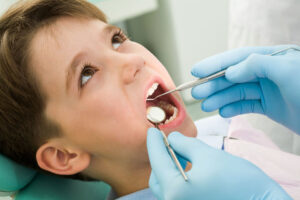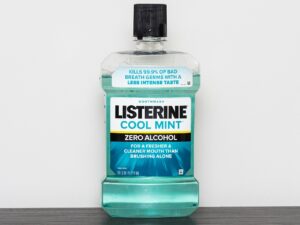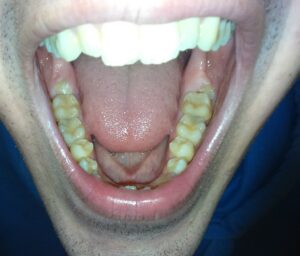Have you ever broken a tooth? Or seen a crack in your tooth? Or had pain from a cracked tooth? If so, then you’ll understand that teeth do that sometimes. Teeth undergo a lot of force, a lot of action, with chewing, sometimes up to 200-300 pounds per square inch on those very back molars. Yes, they are very hard. They are harder than bone. But they are also somewhat brittle. Because of that, you can get certain types of cracks. Today, I’m going to discuss five different types of cracked teeth.
Craze Lines
Craze lines are those little tiny lines that you see if you look really close in the mirror, often in your front teeth. If you could see down the back teeth, you may see them there as well. But they are very, very fine lines that are usually confined to the outer surface of the tooth and the enamel.
Now, the presence of craze lines does indicate there’s stress in those teeth and it’s important to have that evaluated, to see if there’s something going on with unusual bite forces, such as grinding your teeth at night. But craze lines will often stay that way indefinitely, hopefully forever, and not progress to anything more. No further fracture or cracked teeth. They are definitely something to have checked, but they may not result in anything more.
Fractured Cusp
This is the second type of cracked teeth. It is a break or crack that goes to the point that it breaks away one of those points on your teeth, on the side or on the back teeth. Those are called cusps. When those break off, they tend to be a little rough, a little uncomfortable. Sometimes, you’ll sense them, but they don’t usually cause significant toothache in the short-term.
Fracture cusps are cracked teeth you definitely want to get fixed because the tooth is weak, it’s more prone to breaking, and it’s prone to tooth decay because the inside of the tooth is exposed. You want to see a dentist and have something done. Sometimes, a filling can be done, but usually you’re looking at having a cap or a crown put on the tooth or a partial cap or crown known that’s called an onlay. That can restore the tooth back to basically 100% of its original strength.
Cracked Teeth
This is different than craze lines or fractured cusp. Craze lines are those fine little lines on the outer surface. A fractured cusp is a break in the pointy bit of the back teeth. Cracked teeth have a crack that goes in deeper to the tooth to the point that you may have symptoms.
Some cracked teeth don’t cause any symptoms. They just simply break. But other times, you have some pretty good warnings. Those warnings are a combination of two things – cold sensitivity plus sharp bite pain when you bite down on something firm or hard. It’s one of those zingers that makes you sit upright very quickly. If you have those two things together, sensitivity and sharp bite pain, it’s most often a cracked tooth.
Even though the tooth is still together, it’s got this crack that’s extended into it. It’s spreading a little bit when you bite down. The cold is seeping through it and getting close to the nerve. So, that’s a warning system. It’s definitely something to get looked at and treated. In most cases, a cap or a crown can be done on that tooth and that will take care of it. That will be the end of it 9 times out of 10. In other cases, the crack may be deep enough that you may need a root canal prior to having the cap or crown done.
Split Root
This is where a crack goes deeper down into the tooth and actually gets below the gum line and separates the root. This will be in a multi-root tooth like a molar. So, think of a lower molar having two roots going down, one on each side like a pair of legs, and this crack goes through the tooth and actually breaks those two roots in half. In such cases, cracked teeth need to be removed. You may want to consider a solution beyond a cap or a crown for a replacement.
Vertical Root Fracture
This would be a type of cracked teeth where the crack doesn’t go down between two roots but it goes down one root. So, it could be a front tooth which has a single root. The crack just goes from top to bottom, all the way through the tooth, and it splits a single root in half. Or it could be in a molar where it goes down one root and splits that root in half.
This is very similar to the other type of root fracture. But it’s also one of those irreversible situations where cracked teeth need to be removed. Even if the tooth is not hurting because it is going to become infected to some degree at some point. So, that’s something you want to get taken care of.
Takeaway – Get Cracked Teeth Checked Out
A few things to think about when it comes to a cracked tooth, wear and tear, craze lines, and split roots. There’s quite a bit there and it sometimes needs to be addressed.
Here at Express Dentist, we have a full network of trusted dentists around the country. We can help you connect with one in your area. If you suspect you are dealing with cracked teeth, whether there are symptoms or no symptoms, you should have them checked and treated. Reach out to us and we will help you get connected with a dentist in your area. Take care and be well.
About the author

Dr. Greg Grillo
Dr. Greg Grillo DDS studied at the University of Washington where he received a bachelors degree with Honors and later attended dental school on the same campus. Following school Dr. Greg served in the United States Navy as a dental officer. During this time he received advanced training in specialty areas of dentistry while also treating families of members of the military.
As well as sharing valuable information on dentistry and oral health, Dr. Greg remains a practicing dentist to this day. He works with families in the Okanogan Valley where he lives with his wife and three children.
- Dr. Greg Grillo#molongui-disabled-link
- Dr. Greg Grillo#molongui-disabled-link
- Dr. Greg Grillo#molongui-disabled-link
- Dr. Greg Grillo#molongui-disabled-link




